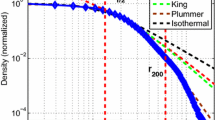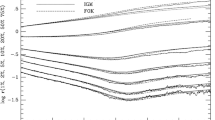Abstract
The dynamics of the collision of two spheroidal galaxies, each of which consists of stellar and gas components inside a live massive dark halo, is considered in detail based on numerical simulations. Dark matter and stars are collisionless components, so their dynamics is modeled by the system of N body particles, and the gas component is described by the equations of gas dynamics. The calculation of gravitational forces is based on the direct summation method of the gravitational contribution from each particle, which provides the highest possible accuracy. We vary the impact parameter, the initial collision velocity, the masses of the three components for each model of the galaxies in order to estimate the relative fractions of the masses that are lost by both galaxies as a result of close interactions, as well as the masses of the gas and stars that are exchanged between the two galaxies during the scattering process. Estimating this exchanged mass of gas requires a Lagrangian approach to simulate gas dynamics, and the smoothed particle hydrodynamics method tracks the trajectory of each smoothed particle. There are two regions of parameters that separate the merging of two objects into one (large merging) and the case of scattering, when both gravitating systems move away from each other after interaction. The collisionless components (dark matter + stars) in the interaction of approximately the same galaxies lose their maximum mass at parameters close to the boundary between merging and scattering. If the initial masses of colliding galaxies differ greatly then the lost fraction of the mass is large for a low-mass object and small for a massive galaxy. The formation of global shock waves in colliding systems is a key factor determining the efficiency of sweeping gas from the gravitational potential well. The efficiency of the stellar-component transition from one object to another is negligible. Gas exchange can exceed 10 percent of the mass for a certain range of values of the impact parameter and the initial collision velocity.








Similar content being viewed by others
REFERENCES
E. Shin, M. Jung, G. Kwon, J. Kim, J. Lee, Y. Jo, and B. K. Oh, “Dark matter deficient galaxies produced via high-velocity galaxy collisions in high-resolution numerical simulations,” Astrophys. J. 899, 25 (2020). https://doi.org/10.3847/1538-4357/aba434
S. Khoperskov, I. Zinchenko, B. Avramov, S. Khrapov, P. Berczik, A. Saburova, M. Ishchenko, A. Kho-perskov, C. Pulsoni, Yu. Venichenko, D. Bizyaev, and A. Moiseev, “Extreme kinematic misalignment in IllustrisTNG galaxies: the origin, structure, and internal dynamics of galaxies with a largescale counterrotation,” Mon. Not. R. Astron. Soc. 500, 3870–3888 (2021). https://doi.org/10.1093/mnras/staa3330
P. J. E. Peebles, “Large-scale background temperature and mass fluctuations due to scale-invariant primeval perturbations,” Astrophys. J., Lett. 263, L1–L5 (1982). https://doi.org/10.1086/183911
G. R. Blumenthal, S. M. Faber, J. R. Primack, and M. J. Rees, “Formation of galaxies and large-scale structure with cold dark matter,” Nature 311, 517–525 (1984). https://doi.org/10.1038/311517A0
A. Pillepich, V. Springel, D. Nelson, S. Genel, J. Naiman, R. Pakmor, L. Hernquist, P. Torrey, M. Vogelsberger, R. Weinberger, and F. Marinacci, “Simulating galaxy formation with the IllustrisTNG model,” Mon. Not. R. Astron. Soc. 473, 4077–4106 (2018). https://doi.org/10.1093/mnras/stx2656
R. H. Wechsler and J. L. Tinker, “The connection between galaxies and their dark matter halos,” Annu. Rev. Astron. Astrophys. 56, 435–487 (2018). https://doi.org/10.1146/annurev-astro-081817-051756
M. Vogelsberger, F. Marinacci, P. Torrey, and E. Puchwein, “Cosmological simulations of galaxy formation,” Nat. Rev. Phys. 2, 42–66 (2020). https://doi.org/10.1038/s42254-019-0127-2
S. Tacchella, B. Diemer, L. Hernquist, S. Genel, F. Marinacci, D. Nelson, A. Pillepich, V. Rodriguez Gomez, L. Sales, V. Springel, and M. Vogelsberger, “Morphology and star formation in IllustrisTNG: the build-up of spheroids and discs,” Mon. Not. R. Astron. Soc. 487, 5416–5440 (2019). https://doi.org/10.1093/mnras/stz1657
G. Zeng, L. Wang, and L. Gao, “Formation of massive disc galaxies in the IllustrisTNG simulation,” Mon. Not. R. Astron. Soc. 507, 3301–3311 (2021). https://doi.org/10.1093/mnras/stab2294
D. Pathak, S. Belli, and R. Weinberger, “Quenching, mergers, and age profiles for z = 2 galaxies in IllustrisTNG,” Astrophys. J., Lett. 916, L23 (2021). https://doi.org/10.3847/2041-8213/ac13a7
I. D. Karachentsev, V. E. Karachentseva, A. A. Suchkov, and E. K. Grebel, “Dwarf galaxy candidates found on the SERC EJ sky survey,” Astron. Astrophys., Suppl. Ser. 145, 415–423 (2000). https://doi.org/10.1051/aas:2000249
P. van Dokkum, S. Danieli, Cohen Y, A. Merritt, A. J. Romanowsky, R. Abraham, J. Brodie, C. Conroy, D. Lokhorst, L. Mowla, E. O’Sullivan, and J. Zhang, “A galaxy lacking dark matter,” Nature 555, 629–632 (2018). https://doi.org/10.1038/nature25767
L. N. Makarova and D. I. Makarov, “Spatial segregation impact on star formation in nearby dwarf spheroidal galaxies,” Mon. Not. R. Astron. Soc. 502, 1623–1632 (2021). https://doi.org/10.1093/mnras/stab143
A. V. Zasov, A. S. Saburova, O. V. Egorov, and A. V. Moiseev, “NGC 90: a hidden jellyfish galaxy?,” Mon. Not. R. Astron. Soc. 498, 101–109 (2020). https://doi.org/10.1093/mnras/staa2283
D. Makarov and I. Karachentsev, “Galaxy groups and clouds in the local (z ∼ 0.01) Universe,” Mon. Not. R. Astron. Soc. 412, 2498–2520 (2011). https://doi.org/10.1111/j.1365-2966.2010.18071.x
A. V. Tutukov, G. G. Lazareva, and I. M. Kulikov, “Gas dynamics of a central collision of two galaxies: Merger, disruption, passage, and the formation of a new galaxy,” Astron. Rep. 55, 770–783 (2011). https://doi.org/10.1134/S1063772911090083
V. A. Vshivkov, G. G. Lazareva, A. V. Snytnikov, I. M. Kulikov, and A. V. Tutukov, “Hydrodynamical code for numerical simulation of the gas components of colliding galaxies,” Astrophys. J., Suppl. Ser. 194, 47 (2011). https://doi.org/10.1088/0067-0049/194/2/47
S. S. Khrapov, A. V. Khoperskov, and V. I. Korchagin, “Numerical modelling of the dynamics of the galactic halos in the colliding galaxies,” Bull. South Ural State Univ., Ser.: Math. Modell. Program. Comput. Software 12 (2), 123–135 (2019). https://doi.org/10.14529/mmp190210
I. Kulikov, I. Chernykh, and A. Tutukov, “A new hydrodynamic model for numerical simulation of interacting galaxies on Intel Xeon Phi supercomputers,” J. Phys.: Conf. Ser. 719, 012006 (2016). https://doi.org/10.1088/1742-6596/719/1/012006
S. S. Khrapov, S. A. Khoperskov, and A. V. Khoperskov, “New features of parallel implementation of Nbody problems on GPU,” Bull. South Ural State Univ., Ser.: Math. Modell. Program. Comput. Software 11 (1), 124–136 (2018).
A. M. Fridman and A. V. Khoperskov, Physics of Galactic Disks (Cambridge International Science, Cambridge, 2013).
A. A. Smirnov, N. Ya. Sotnikova, and A. A. Koshkin, “Simulations of slow bars in anisotropic disk systems,” Astron. Lett. 43, 61–74 (2017). https://doi.org/10.1134/S1063773717020062
J. J. Monaghan, “Smoothed particle hydrodynamics,” Rep. Prog. Phys. 68, 1703–1759 (2005). https://doi.org/10.1088/0034-4885/68/8/R01
S. Khrapov and A. Khoperskov, “Smoothed-particle hydrodynamics models: implementation features on GPUs,” Commun. Comput. Inf. Sci. 793, 266–277 (2017). https://doi.org/10.1007/978-3-319-71255-0_21
V. I. Bogatko and E. A. Potekhina, “To the problem of modeling gas flows behind the strong shock wave front using an effective adiabatic index,” Vestn. St. Petersburg Univ.: Math. 53, 77–81 (2020). https://doi.org/10.1134/S1063454120010033
S. Khrapov, A. Khoperskov, and V. Korchagin, “Modeling of spiral structure in a multi-component Milky Way-like galaxy,” Galaxies 9, 29 (2021). https://doi.org/10.3390/galaxies9020029
ACKNOWLEDGMENTS
We express our appreciation and deep gratitude to Associate Professor Sergei Sergeevich Khrapov for valuable comments and for kindly providing programs for parallel computing on GPUs.
Funding
This work was supported by the Ministry of Science and Higher Education of the Russian Federation (government task no. 0633-2020-0003).
Author information
Authors and Affiliations
Corresponding authors
Ethics declarations
Cite this work: Titov A.V. and Khoperskov A.V., Numerical modeling of collisions of spheroidal galaxies: mass loss efficiency by baryon components, Vestn. S.-Peterb. Univ., Ser. 1: Mat., Mekh., Astron., 2022, vol. 9 (67), no. 1, pp. 176–189 (in Russian). https://doi.org/10.21638/spbu01.2022.117
Additional information
Translated by E. Seifina
About this article
Cite this article
Titov, A.V., Khoperskov, A.V. Numerical Modeling of the Collisions of Spheroidal Galaxies: Mass Loss Efficiency by Baryon Components. Vestnik St.Petersb. Univ.Math. 55, 124–134 (2022). https://doi.org/10.1134/S1063454122010149
Received:
Revised:
Accepted:
Published:
Issue Date:
DOI: https://doi.org/10.1134/S1063454122010149




